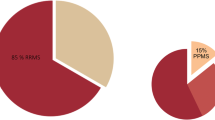Abstract
Volumetry of the brain can provide fundamental information about the development and function of the normal human brain and can yield important clues for pathology in patients suffering from neurological brain disorders (see Jernigan et al. [713]). Valuable information has been gained about the pathological processes in epilepsy (see Stone et al. [714]) and Alzheimer’s disease (see Tanabe et al. [715]) from the volume measurements of various brain structures. Brain tissue in Alzheimer’s disease was compared with elderly control volunteers by using an MR-based computerized segmentation program. Semi- automated segmentation of MR brain images revealed significant brain atrophy with significant white matter hyperintensities. In many focal diseases such as Multiple Sclerosis (MS) and cancer, the total lesion volume is indicative of the overall disease burden and may be useful in the quantification and objective evaluation of therapeutic intervention in disease (see Dastidar et al. [716] and Fillippi et al. [717]). These investigators demonstrated that MRI images provide excellent quantitative MRI tissue volume measurement. Different tissues can be identified on the images, either manually or by computer-assisted means for computing the volumes. The process of identifying and isolating a given tissue is generally referred to as segmentation. Segmentation allows color-coding of different tissues for improved delineation and makes for easier visual identification of pathology. Segmentation is evaluated as being useful in radiation therapy (see Vaidyanathan et al. [718]) and for simulating sensitive procedures for interventional neurosurgery (see Dickson et al. [719]).
Access this chapter
Tax calculation will be finalised at checkout
Purchases are for personal use only
Preview
Unable to display preview. Download preview PDF.
Similar content being viewed by others
Editor information
Editors and Affiliations
Rights and permissions
Copyright information
© 2002 Springer-Verlag London
About this chapter
Cite this chapter
Sharma, R., Suri, J.S., Narayana, P.A. (2002). Segmentation Techniques in the Quantification of Multiple Sclerosis Lesions in MRI. In: Suri, J.S., Setarehdan, S.K., Singh, S. (eds) Advanced Algorithmic Approaches to Medical Image Segmentation. Advances in Computer Vision and Pattern Recognition. Springer, London. https://doi.org/10.1007/978-0-85729-333-6_5
Download citation
DOI: https://doi.org/10.1007/978-0-85729-333-6_5
Publisher Name: Springer, London
Print ISBN: 978-1-4471-1043-9
Online ISBN: 978-0-85729-333-6
eBook Packages: Springer Book Archive




